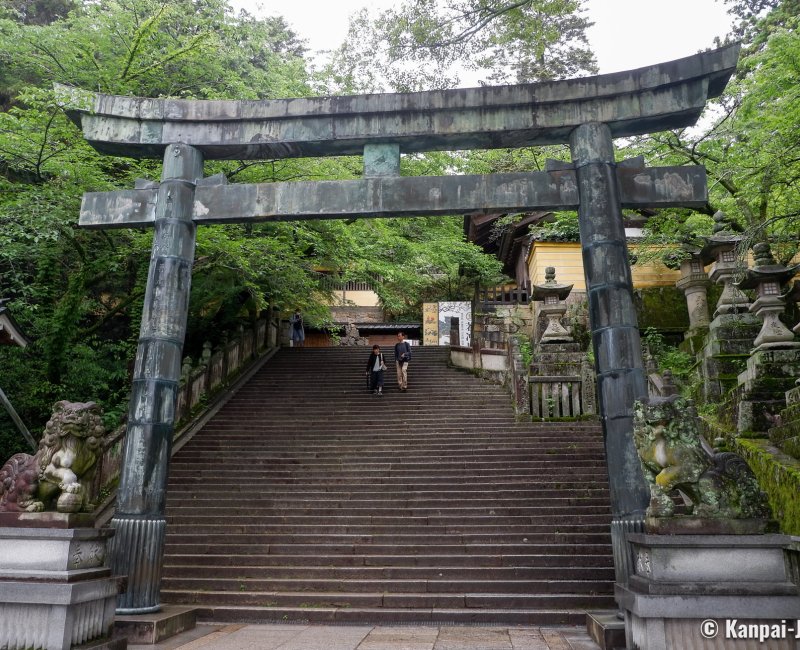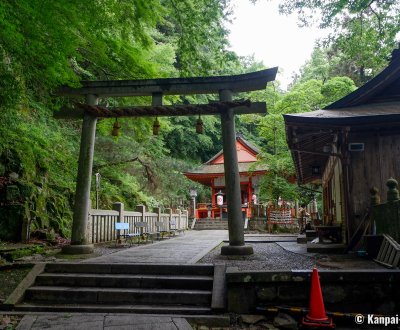Kotohira-gu
Konpira-san, The Sailors’ Shrine
Kotohira-gu, commonly nicknamed Kompira-san, is a Shinto shrine located in Kotohira, a small town of Kagawa Prefecture. Spreading on Mount Zozu, it is dedicated to the protection of sailors and seafaring. Its rich folklore and its 1368 steps to climb to the top make it a very popular pilgrimage, complementary to Shikoku’s 88 temples pilgrimage route.
Mount Zozu has been a spiritual place at least since the 1rst century. Matsuo-ji temple was founded there around 700-704 by followers of the shugendo, a syncretistic cult blending Buddhism and Shinto. As for Kotohira-gu, it was build to ensure the protection of the kami deities, represented by Omono-nushi the guardian of seafaring, likened to the aquatic deity of the Indian Buddhist pantheon Khumbira (Kompira in Japanese). In 1165, emperor Sutoku's supposedly vengeful spirit was enshrined along with the already many other deities to watch over the place.
An ancient pilgrimage
The Kompira-san pilgrimage’s popularity started to rise in the 14th century, and it even became the 2nd most visited sanctuary during the Edo period, after Ise Jingu. Japanese people still enjoy the place nowadays and visit throughout the year. It indeed offers an active walk under the shadows of the forest, with various stops along the way on the side of the mountain: oratories, museums or remarkable pavilions, as well as beautiful elevated views on the Sanuki plain and Mount Iino (nicknamed "Sanuki Fuji 🗻") and up to the Seto Inland Sea.
Kotohira-gu Kompira-san is the most important of the 600 Kompira shrines existing in Japan, and people mainly come here to pray for safety at sea, by offering ema plates illustrated with a ship, or for happiness, specifically addressed by yellow omamori amulets.

First part of the pilgrimage: 785 steps to the Hongu
Kotohira City is served by 2 train 🚅 stations, near which is standing the tallest lantern 🏮 of Japan (27 meters high), and it takes a 15-20 minutes’ walk to reach the shopping district at the foot of the sanctuary. You’ll find there:
- Rental booths for walking poles;
- Udon noodles restaurants and even a school to learn how to make them;
- A sake museum; and, in the vicinity,
- Umi no kagakukan, a museum dedicated to navigation at sea.
The first 365 stone steps, lined with restaurants, souvenir and confections shops, lead to the Oomon (or Daimon) gate that marks the formal entrance of Kotohira-gu. This gate, as well as several other buildings on the site, show Buddhist influences in a reminder that both Shinto and Buddhism have long coexisted in most of Japan’s places of worship.
Oomon gate opens on a first landing and the paved Sakura 🌸-baba alley, of about 150 meters long. With its cherry trees on both sides, it is an ideal spot for viewing the sakura blossoms in spring. On the right of the stairway, the Treasure Hall Homotsu-kan displays a more contemporary architecture and shelters a statue of 11-headed Kannon. The path, lined with lanterns and steles engraved with the names of their donors, continues to another landing marked by a torii ⛩️ gate, characterized by:
- The Takahashi Yûichi Museum, dedicated to the precursor of Western-style painting in Japan;
- Omote sho-in, a building designated Important Cultural Property and home to 18th century paintings on fusuma doors by Maruyama Okyo;
- 2 sacred horses;
- An upscale restaurant and coffee shop.

At the 431th step, you’ll find a small statue of a dog carrying a bag on its neck. It is the Kompira-inu, a tribute to the dogs sent by their owners to the Kotohira-gu pilgrimage in their stead during the Edo period. The pets were entrusted to travelers with a bag containing the prayer and offerings for the shrine, as well as the food necessary for such a journey.
Another stone torii gate opens on a steeper stairway to the impressive structure of the Asahi-sha pavilion at the 628th step. A covered gallery in front of the building offers seating to admire the 18 meters high building, ornamented with numerous sculpture, and whose construction was achieved in 1837 after 40 years of work.
Then, on the right, a discreet gate opens on the last part of the ascension: an impressive stairway to the landing of the 785th step, where is standing the main pavilion Hongu, dating back to 1878. On the left, you’ll find several other wooden structures open to visitors as well as the shrine’s "shop" selling the ema and omamori. On the right, the platform becomes an observatory on the Sanuki plain, 251 meters above sea level, with an unobstructed view towards Marugame City. Most of visitors stop here and come back down using the dedicated stairway.

Ascending to the mysterious tengu
However, the pilgrimage route continues, and you’ll have to walk about 1km and climb 583 other steps to the most secluded shrine, Oku no sha (also called Izutama-jinja). This path is far less busy and the thick forest adds to the mystical atmosphere of the ascension. The course is dotted with several smaller shrines (not open to the visit), including the one dedicated to emperor Sutoku, Shiromine-jinja.
After a rather sporty climb, and encouraged by people on their way back, one arrives at the Oku no sha’s small space: a simple and small red pavilion protected by 2 tengu 👺 masks 😷 engraved in the cliff above. Confirmation of the end of the road is displayed on the wooden building on the side, after 1368 steps, at 421 meters above sea level. Goshuin seals with the date of the day and only available here are painted by a priest on demand.
Stay focus to go back down the mountain, and at this point a trekking pole might prove useful as there are no handrails on the steep stairways. The hike is possible provided being in good fit, with the proper walking shoes and bringing enough water as there are almost no drink vending machines in the shrine’s grounds. At the foot of the mountains, you can replenish your strength at affordable udon noodles restaurants or wasanbon sugar cane sweets ice cream parlors.
Kanamaru-za, the oldest Kabuki theater, designated Important Cultural Property, is also located in the vicinity for a discovery of the behind the scenes of a traditional theatrical performance.
If you still have some strength left, you can go to Zentsu-ji, about 10 minutes’ ride on a JR train. Zentsu-ji is the city of birth of Kukai (Kobo Daishi), the founder of Shikoku 88 temples pilgrimage, and home of the eponymous temple and its 500 statues of Buddha’s disciples.


